NHL Power Rankings: Top 25 players under 25

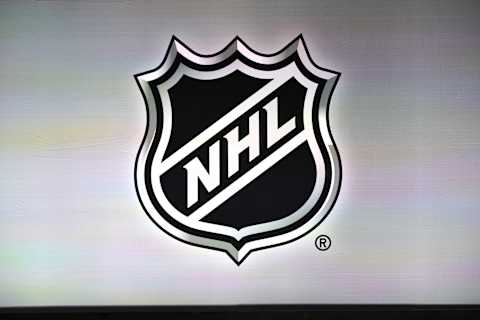
The NHL has a plethora of young talent. Let’s take a look at the NHL Power Rankings of the best 25 players under 25 years old entering the 2018-19 season.
The NHL is experiencing a transitional period. New stars are taking the torch from the older ones. And the students are proving to be as good as the teachers, if not even better. Recent drafts have produced outstanding young talent. This week’s NHL Power Rankings will take a look at just how deep this young core is.
A new group of young players are poised to take the league to new heights. This year’s top 25 players under 25 years old was extremely difficult to put together. That’s a testament to how many great players there are around the league.
Criteria
These rankings were created based on several factors. First of all, results matter the most. There’s a saying – “potential is wasted talent”. That might not be completely true, but it hammers home the point that results are the best way to evaluate players.
Secondly, yes, potential matters. Most players under 25 aren’t quite done improving yet. The common belief is players will hit their prime right around the age of 23 years old. Some do so earlier, and others later. Factoring in potential will also help give younger players a chance on this list against players who will undeniably have better results since they’ve been around for longer.
To be eligible for this list, players must be 25 years old or younger on October 31st of 2018. No one will agree with these rankings, so feel free to discuss things in the comments.
Before we begin, let’s take a look at some of the players who just barely missed the cut. It was incredibly difficult to make this list and some darn good players had to be left off.
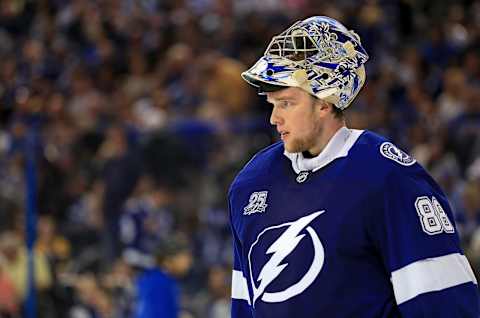
Honorable Mentions
There was a list of about 30 players who made the second-to-last cut. I can’t emphasize how hard it was to cut it down to 25. There’s a good argument for each of these players deserving to be on this list. In a way, this is a bit encouraging. It’s proof of how much young talent there is around the NHL.
Andrei Vasilevskiy
I think very highly of Tampa Bay Lightning goaltender Andrei Vasilevskiy. He’s a ton of fun to watch because of his outstanding athleticism. It seems like he makes a jaw-dropping highlight reel save at least once per game.
However, it’s worth noting Vasilevskiy played on a team that curb-stomped the competition into the ground in the first half and coasted to the Atlantic Division title. With goalies, you have to separate factors they can control and factors they can’t. As great as Vasilevskiy was last season, his team gave him a ton of help.
Charlie McAvoy
McAvoy was one of the last players I left off this list. There’s just too many good players to include everyone. And it’s really unfortunate I had to leave McAvoy off the list because he’s such an outstanding talent.
Every time I watch him play, I have to remind myself he’s only 20 years old because he plays like a veteran. McAvoy has the hockey IQ of someone who’s at least 30. He does so many little things right. It’s impressive to see a young player so good at doing those things. Combined with his skating and well-balanced game, that’s a lethal combination. Expect to see McAvoy on this list next year once a few players graduate.
It was really difficult for me to leave Jaccob Slavin, Aaron Ekblad, and Noah Hanifin off the final list as well.
Brayden Point
Point was the last forward left off this list. My decision came down to potential versus production, and I took the latter. Barring anything unforeseen, Point will be on this list next season. I’d be shocked if he isn’t.
Rasmus Dahlin
No, I didn’t put Rasmus Dahlin on this list. It’s not fair to the people on it, nor is it fair to the 2018 first overall pick. Prospects are unknown quantities. That said, Dahlin should be headlining this list next season. Nothing I’ve seen from him suggests he’s anything less than a borderline generational blueline talent. Dahlin might well be generational. But let’s see how he does in the NHL first.
Others: Nico Hischier, Teuvo Teravainen, Will Butcher, Nolan Patrick, Aaron Ekblad, Mikhail Sergachev, Sean Monahan, Kyle Connor, Jaccob Slavin, Max Domi, Dylan Larkin, Anthony Mantha, Shea Theodore, Noah Hanifin.
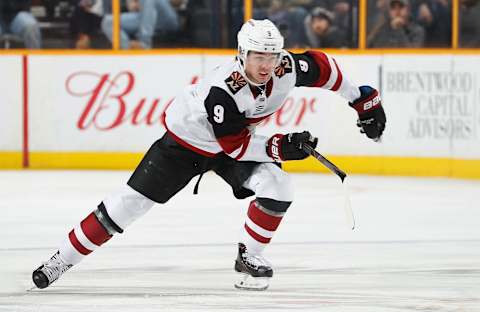
121. . Forward. Arizona Coyotes. Clayton Keller. 25. player
Clayton Keller entered the 2017-18 season as one of the Calder Trophy favorites (though it’s worth noting that award is usually the hardest one to predict). He finished in third place after an extremely impressive rookie season. Keller provided a lot of excitement for the Coyotes, putting up 23 goals and 65 points. Arizona only scored 208 goals last season, meaning he was a part of 31.25 percent of their goals.
Keller provided a lot of excitement for the Coyotes, putting up 23 goals and 65 points. Arizona only scored 208 goals last season, meaning he was a part of 31.25 percent of their goals.
Keller’s 1.97 five-on-five points per hour were higher than such players as Mitch Marner, Jakub Voracek, Josh Bailey, Evander Kane, and Nazem Kadri. He got a point on nearly half of the Coyotes 41 power play goals, picking up 20 points, including six goals. Keller’s rate stats aren’t overly impressive at first glance, but once you realize how important he was to his team’s offense, they’re extremely good.
So far, he hasn’t shown that he can drive possession. But usually, that’s a skill that takes a while to develop in the NHL. Keller was above average as far as zone entries and, though he rarely exited the defensive zone, he had a very solid success rate.
He needs to be more confident in his shot as well. But Keller’s already a very impressive playmaker. Last year, Keller was very dominant and this year should be no different. Once he irons out the wrinkles in his offensive game, he should shoot up this list.

Ivan Provorov. 24. player. 68. . Defenseman. Philadelphia Flyers
As the top 25 players under 25 lists have started to trickle out, there’s been one player who hasn’t been a part of them who really should be – Ivan Provorov of the Philadelphia Flyers. Even though I’m a Capitals fan, I recognize talent when I see it. Provorov has quickly emerged as one of the best young defensemen in the NHL.
In a year or two, Provorov will be the Flyers best defenseman. He might be already.
He’s a bit underrated, though that’s hardly his fault. Provorov’s production isn’t overly impressive, but that’s largely because he rarely plays on the Flyers top power-play unit. That’s Shayne Gostisbehere’s role (and rightfully so).
Last season, though, Provorov showed what’s he truly capable of. Not only did he post impressive possession numbers, he scored 17 goals, setting a career-high. It’s rare to see a defenseman with a shooting percentage of over eight percent, but Provorov has the kind of shot that could make that somewhat sustainable. He also posted 24 assists and 41 points.
As long as Gostisbehere is on the Flyers, Provorov will likely remain in his shadow. But if you look hard enough, you’ll see how great he truly is. Provorov plays with a poise that is rare to see from young defensemen. And he’s only 21 years old. In a year or two, Provorov will be the Flyers best defenseman. He might be already.
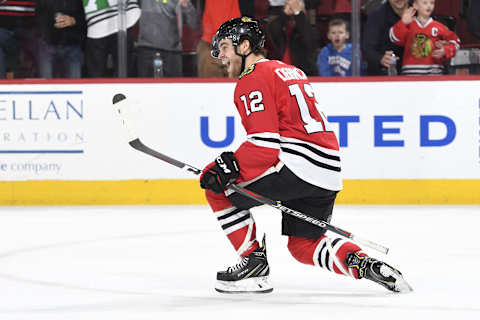
. Forward. Chicago Blackhawks. Alex DeBrincat. 23. player. 94
Alex DeBrincat’s rookie season went a bit under the radar thanks to one of the deepest rookie classes in recent memory. However, the Chicago Blackhawks rookie made a significant impact and proved why he should have been a first-round pick back in 2016.
It’s crazy to think he’s only 20 years old. Every year, DeBrincat’s shot has gotten better. Which is really scary to think about. Unless you’re a Blackhawks fan.
It’s a bit baffling DeBrincat fell as far as he did in the 2016 draft. His size likely played a role in it, but still, he put up consistently elite numbers wherever he went in juniors. DeBrincat’s calling card as a draft prospect was his ability to score goals. This skill has translated very well to the NHL, as he finished third in goals among rookies with 29. DeBrincat also finished tied for sixth in points.
What separates him from other smaller players is, much like recent graduate Johnny Gaudreau, he knows how to use his lack of size as an advantage. Anything can be a skill or an advantage if you see it as such and use it as such. DeBrincat is extremely mobile and is already great at sneaking into tough areas, getting pucks, and getting out.
It’s crazy to think he’s only 20 years old. Every year, DeBrincat’s shot has gotten better. Which is really scary to think about. Unless you’re a Blackhawks fan.
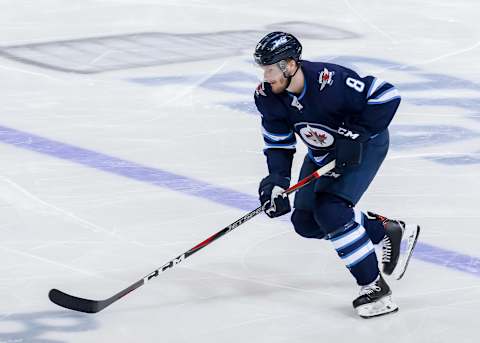
30. . Defenseman. Winnipeg Jets. Jacob Trouba. 22. player
Jacob Trouba and the Winnipeg Jets have a fascinating relationship, to say the least. The former wants a long-term deal, but the latter seems unwilling to do so. Maybe Trouba doesn’t want to sign long-term. But whatever the reason, the Jets need to do whatever it takes to keep him around.
Most of each game is played at five-on-five. Hence, Trouba doing extremely well at five-on-five is extremely valuable.
Trouba has developed into an all-around great defenseman. His offensive production isn’t flashy, but he’s averaged at least 0.40 points per game in each of his past two seasons, which is pretty good for a defenseman. Also, it’s worth noting Trouba gets minimal power-play time (a shade under 90 seconds per game) and ranked 15th in five-on-five points per hour among defensemen (minimum 775 minutes played).
He makes the Jets a better team at five-on-five. That’s where a lot of Trouba’s value lies. And lest you think the Jets are dumb for not giving him more power-play time, Dustin Byfuglien is rightfully on the first power-play unit and is a huge catalyst for them.
Most of each game is played at five-on-five. Hence, Trouba doing extremely well at five-on-five is extremely valuable. Despite having to play on his off-side and having to play with Mark Stuart constantly early in his career, it’s unquestionable he’s one of the best defensemen in the NHL today.

There are certain players who warranted a double-take once I realized they’re under 25 years old. Toronto Maple Leafs defenseman Morgan Rielly probably got the biggest one. It feels like he’s been around forever, but yup, he’s just 24 years old and doesn’t turn 25 until March 2019.
The deck has been stacked against him and he’s still managed to prove himself. That tells you how good Rielly truly is.
Rielly finally showed off his true potential last season. He nearly doubled his previous season’s total in points (27) with a career-high 52 points in 2017-18. Rielly was asked to play during all situations and it’s hard to argue he didn’t make the Leafs a better team. Despite sub-optimal deployment, he still managed to finish in the top 30 among defensemen in five-on-five points per hour.
Now, his possession stats are underwhelming, to say the least. But let’s give some context. Rielly had to play most of the season with Ron Hainsey. Let’s just say that’s a pairing that Leafs fans should hope to never see again. Rielly carried his partner and without him, Hainsey was dreadful. Meanwhile, Rielly posted better numbers without him.
It’s fascinating how quickly the NHL has shifted. Up until very recently, most of the best defensemen in the league were left-handed. But thanks to guys like Brent Burns, Erik Karlsson, and P.K. Subban (among others), southpaw defensemen are about as common as unicorns. Rielly’s easily one of the best left-handed defensemen in the NHL.
The deck has been stacked against him and he’s still managed to prove himself. That tells you how good Rielly truly is.
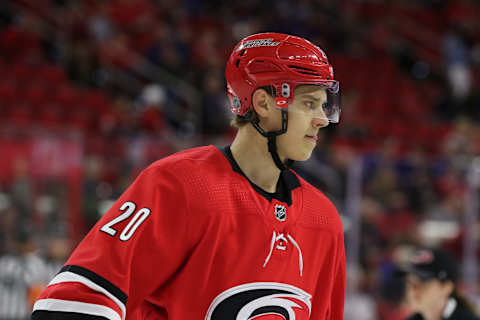
109. . Forward. Carolina Hurricanes. Sebastian Aho. 20. player
There are two players named Sebastian Aho in the NHL. The one on the Carolina Hurricanes is the best of the two. Aho is not a household name yet, but he probably will be one very soon. Finland’s NHL pipeline is led by some impressive goal scorers, including Patrik Laine (more on him much later). Aho is arguably the second best among them.
Aho is not a household name yet, but he probably will be one very soon.
Last season, Aho and Teravainen were outstanding together at five-on-five. The Hurricanes have been searching for a top forward line to build around and they have found at least two members of that elusive trio. After an impressive 49 point rookie season, Aho nearly scored 30 goals for the first time, finishing with 29. Not only that, he put up 65 points.
Moreover, Aho managed to crack the top 30 forwards in five-on-five points per hour. That’s even more impressive once you realize how bad the Hurricanes were at scoring. Aho’s only 21 years old, so his best years are still ahead of him.
His relative possession numbers aren’t outstanding, but it’s worth noting Carolina has impressive numbers across the board there. So that’s likely more telling of the latter than Aho’s possession skills. He had a phenomenal season in 2017-18, but expect an even better one in 2018-19.
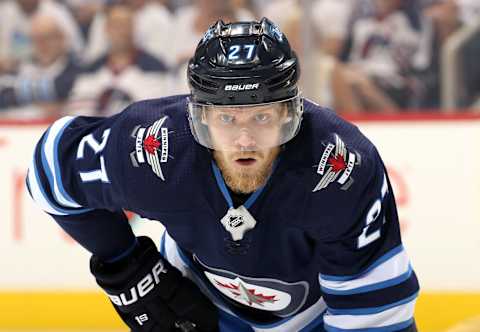
30. . Forward. Winnipeg Jets. Nikolaj Ehlers. 19. player
Perhaps nothing is more telling of how comically deep the Jets are than Nikolaj Ehlers only plays about 13 minutes a night at five-on-five. He cracked the top 60 forwards in five-on-five goals per hour, five-on-five primary assists per hour, and five-on-five points per hour. Ehlers is equally impressive as far as possession, as he’s a pretty significant net positive for the Jets there.
There are not many things the analytics test and the eye test agree on. But one of the very few things that’s pretty much unanimous in the hockey community is Ehlers is one heck of a talent.
His point production fell from 64 to 60 last season, but I’m still really high on him. Ehlers passes both the analytics test and the eye test with flying colors. His playmaking makes him a valuable asset wherever he plays in the lineup.
Moving forward, Ehlers is at worst a top six forward. On a team less stacked than the Jets, he’d probably be a top line forward. Ehlers’ ability to carry a line as a wing makes him more valuable on the second line with Little than it does on the first line with Mark Scheifele and Blake Wheeler, who need no help there.
Wings who can carry a line are quite rare. Ehlers is one of them and he’s proven this over the past two seasons. He’s just hitting his prime as well and the Jets were really smart to lock him up long-term early on.
There are not many things the analytics test and the eye test agree on. But one of the very few things that’s pretty much unanimous in the hockey community is Ehlers is one heck of a talent.
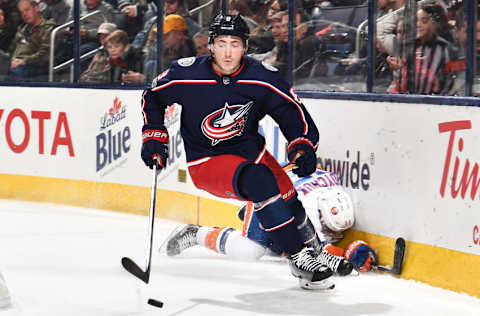
The Blue Jackets have two defensemen on this list. Zach Werenski is the first. Even though the Blue Jackets power play was awful in 2017-18, he was able to remain very productive with 37 points in 77 games.
Werenski’s ability to score is fascinating as a defenseman. And he’s proven he can handle top pairing duties while still producing at an impressive rate.
Werenski’s five-on-five production has been consistently impressive in his first two seasons. In 2017-18, he cracked the top 50 defensemen in five-on-five points per hour. Werenski’s goal scoring is his calling card, which is unique for a blueliner. Among defensemen with at least 1,400 five-on-five minutes, Victor Hedman and Provorov were the only two to score more five-on-five goals per hour than him.
His numbers should have him higher on this list. But I question how much of his success is due to his partner Seth Jones (more on him later). His lack of assists is a little concerning as well. That said, Werenski’s ability to score is fascinating as a defenseman. And he’s proven he can handle top pairing duties while still producing at an impressive rate.
Expect Werenski’s production to improve in 2018-19 if the Blue Jackets can figure out what ailed their power-play in 2017-18. He’s easily among the top 20 players under 25 years old. But I have a feeling we haven’t seen the best of Werenski yet. His partner enters the 2018-19 season as a Norris Trophy candidate. And remember, behind (almost) every Norris candidate is a partner helping him and optimizing his abilities.
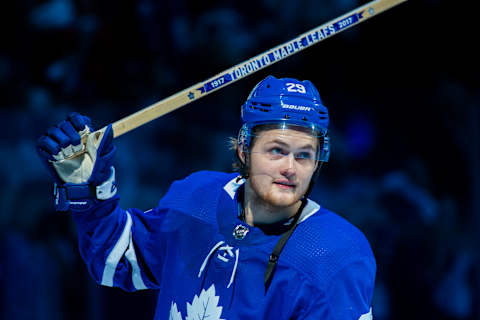
William Nylander is an extremely special player. Going into the 2014 NHL Draft, the biggest question with him was how his creativity and tendency to overhandle the puck would play in the NHL. After consecutive 60 point seasons, it’s safe to say Nylander has addressed those concerns.
Nylander is already a darn great player who I love watching. But he can be even better. And at 22 years old, he still has some time to blossom.
His ability to set up scoring chances stands out as his most dominant trait. Last season, Nylander finished just outside of the top 10 among forwards in primary assists per hour at five-on-five. He also cracked the top 30 in points per hour.
That said, let me address the one concern I have with Nylander, which kept him from being higher on the list. His goal scoring rates aren’t good. However, Nylander sets his teammates up for goals at a very impressive rate. Still, you’d like to see him score a bit more than 12 goals at five-on-five. And this wasn’t just a case of Nylander being snake bit either – Corsica had him at 13.78 expected five-on-five goals last season.
It’s clear Nylander is at worst a great complementary player. The kind that is worth investing in long-term. Nylander makes his teammates better. However, entering the 2018-19 season, it’s time for him to turn the corner and become an even better player. Nylander is already a darn great player who I love watching. But he can be even better. And at 22 years old, he still has some time to blossom.
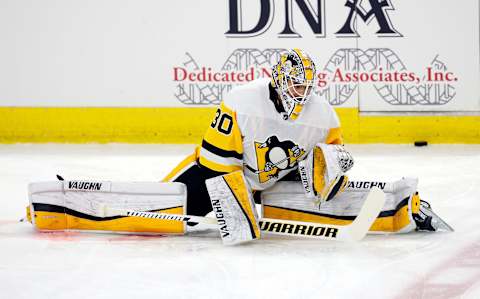
Goaltender. Pittsburgh Penguins. Matt Murray. 16. player. 92.
Matt Murray is coming off of a season when everything that could have gone wrong went wrong. First of all, he suffered some early injuries, which didn’t let him get into a rhythm. And, if you paid attention during the 2015-16 and 2016-17 regular season and playoffs, you know how good Murray can be if he gets in a rhythm.
When you evaluate goalies, it’s important to recognize what they can and can’t control. I’d wager most of the factors that caused his bad season are ones he couldn’t control.
Secondly, his father passed away. It hit Murray quite hard. Lastly, once he started to get in a rhythm despite getting dealt a really bad hand, he suffered a concussion. All of this adds up to a season that makes you question if Murray broke a mirror or something.
I have a lot of faith in him to rebound. Murray has put up eye-popping numbers at every level he’s been at, whether it be juniors, the AHL, or the NHL. It’s safe to say his .907 save percentage from last season is likely an outlier. When you evaluate goalies, it’s important to recognize what they can and can’t control. I’d wager most of the factors that caused his bad season are ones he couldn’t control.
No Penguins player needed a long offseason more than Murray. The Pens have used him a lot over the past three seasons. Sometimes, a reset is all a goaltender needs to get back to where they were. Murray has every tool you look for in a top goaltender. His 2017-18 season was rough, but expect him to shoot up this list and re-insert himself in the “elite goalie” conversation in 2018-19.
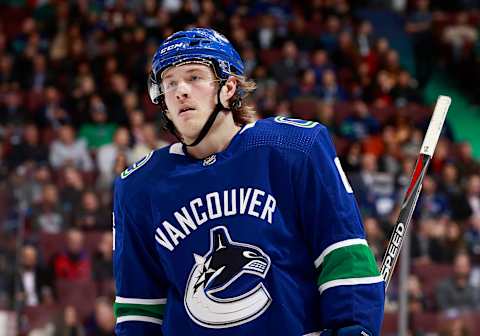
104. . Forward. Vancouver Canucks. Brock Boeser. 15. player
Brock Boeser of the Vancouver Canucks electrified the NHL last season. I’m not sold on him being an elite goal scorer yet, but he passes the eye test with a lightning quick and powerful release. It will, however, be tough for Boeser to maintain a shooting percentage of 16.2 percent because that’s Steven Stamkos-esque. You shouldn’t assume someone can convert on roughly one of six shots on goal until they prove they can do it.
It’s hard as heck to score goals in today’s game. So if you can find an elite goal scorer, that’s an extremely valuable thing. Boeser has the potential to be one.
If he can get his shots per game rate over three per game, 30 goals is a perfectly reasonable expectation for the 2018-19 season assuming he’s healthy. Playing regularly with either Bo Horvat or Elias Pettersson (who could very well be on this list 12 months from now) should be a huge boost.
It’s hard as heck to score goals in today’s game. So if you can find an elite goal scorer, that’s an extremely valuable thing. Boeser has the potential to be one. And, last season, he was arguably among the elite.
Can Boeser be a building block as a wing? That’s a critical question he’ll have to answer in 2018-19 as he looks to prove he’s deserving of a long-term commitment. Boeser will be an RFA after next season. The Canucks would be wise to lock him up for eight years as soon as they can.

Mikko Rantanen. 14. player. 103. . Forward. Colorado Avalanche
Mikko Rantanen had a breakout season in 2017-18. The Finnish wing had his second straight season with at least 20 goals and just barely missed the 30 goal plateau with 29 goals. Rantanen more than doubled his output from the 2016-17 season, going from 38 points to an eye-popping 84 points.
Rantanen more than doubled his output from the 2016-17 season, going from 38 points to an eye-popping 84 points.
Now, let’s address the pink elephant in the room. Yes, Rantanen’s numbers were certainly helped by Nathan MacKinnon’s Hart Trophy-worthy season. But let’s take a look at how Rantanen did in those eight games his center missed. In those eight games MacKinnon missed, Rantanen still put up six points. Obviously, a drop off in production from his point per game rate over the full season. But it’s a small sample size and six points in eight games is still pretty good.
My big question about Rantanen entering the 2018-19 season is if he’s one of those guys who can drive a line. Because if he can, that’s incredibly valuable as a wing. It’s worth noting next season is Rantanen’s last year of his entry-level deal. So he could be setting himself up for a massive payday. Nylander’s contract should set the floor, as Rantanen has shown more than him. But there’s another Leafs forward who Avalanche fans should be looking for if you want a comparable player. Speak of the devil…

Mitch Marner has developed into one heck of a player. The Maple Leafs have their “big three” and he’s likely the second best of the bunch. Marner doesn’t score quite as much as you’d like a wing to, but 22 goals isn’t too shabby. His shot rate improved from 2016-17 to 2017-18, so that’s a good sign.
Marner’s playmaking ability is what stands out. It feels like at least once every two games or so, he’ll pass up a good shooting opportunity. Usually, that’s not good. But Marner will then set up an even better one for one of his teammates. He needs to be a little bit more aggressive when shooting the puck, but it’s hard to argue with his results.
Marner’s playmaking ability is what stands out. It feels like at least once every two games or so, he’ll pass up a good shooting opportunity. Usually, that’s not good. But Marner will then set up an even better one for one of his teammates.
His five-on-five production was above league average, but he really stood out on the power-play. Marner’s creativity, skating ability, and high hockey IQ make him a lethal threat when there’s one fewer opponent on the ice.
No matter what line he’s on, he makes that line better, which makes me think Marner’s a guy who can carry a line. Or at the very least, make it a lot better. Rantanen and Marner are extremely similar. For me, Marner’s ability to make his linemates better was the determining factor.
On paper, he should get a lot of playing time with either Auston Matthews or John Tavares. With Marner’s entry-level deal ending after the 2018-19 season, the Maple Leafs should lock him up before he starts playing with an elite center on a regular basis. Because once that happens, it wouldn’t surprise me if he’s a point per game guy.
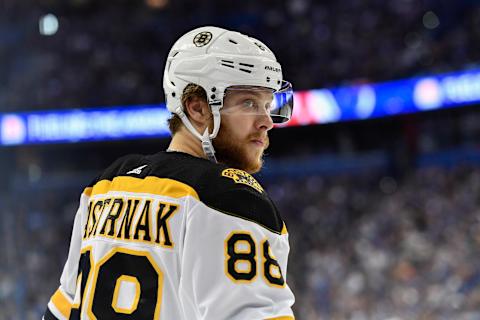
12. player. 70. . Forward. Boston Bruins. David Pastrnak
I’m fascinated by David Pastrnak of the Boston Bruins. On one hand, you should be wary of anyone who plays a ton of minutes with Patrice Bergeron and Brad Marchand. They could pick a bum off the streets, put them with Bergeron and Marchand, and they would probably turn him into a 20 goal scorer.
Pastrnak hasn’t been given the opportunity to prove he’s a guy who can carry his own line, but I believe he’s one of those types.
But, on the other hand, Pastrnak is really, really good. That’s putting it lightly. He’s been the best forward Bergeron and Marchand have played with over the past few seasons. On paper, Pastrnak completes the trio by providing a top-notch offensive talent who can turn a deadly shutdown duo who can score at a great rate to one that can put up points at will.
As nuts as it might sound, the Bruins should explore putting Pastrnak on his own line. First of all, there’s a good chance whoever you put with Bergeron and Marchand is going to do well. Secondly, the Bruins are a bit top heavy and could use a difference maker on the second line. Pastrnak has the talent to be that guy. The Bruins have enough intriguing young talent that they can afford to put him on the second line. David Krejci is a bit of a dropoff from Bergeron, but he’s still a very solid center when healthy and would benefit from some help on his wing.
Pastrnak hasn’t been given the opportunity to prove he’s a guy who can carry his own line, but I believe he’s one of those types.
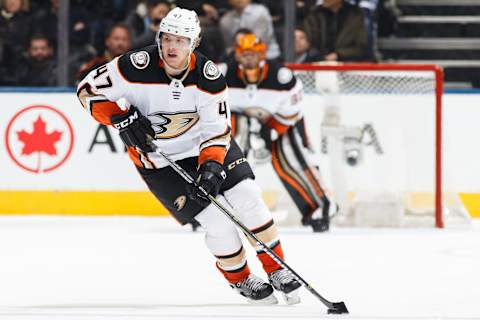
Defenseman. Anaheim Ducks. Hampus Lindholm. 11. player. 105.
Hampus Lindholm of the Anaheim Ducks is the best defenseman you’ve never heard of. He’s among the NHL’s most underrated players, largely because over half of his games are played when a majority of the big NHL markets (Toronto, Boston, New York, Montreal, etc.) are asleep. That’s a darn shame because Lindholm is easily one of the best defensemen in the NHL.
Lindholm is poised in his own zone and flourishes despite having an offensive zone start percentage of below 50 percent.
What stands out about him is his overall ability. Lindholm’s production rates aren’t that impressive, but he’s still above the 50th percentile. He really stands out on defense, as the Ducks allow far fewer shot attempts at five-on-five with him on the ice. Among defensemen with at least 1,000 five-on-five minutes, only Colin Miller had a larger impact on shot suppression. Unlike Miller, Lindholm wasn’t sheltered.
You could make an argument he’s the best defensive defenseman in the league. Lindholm is poised in his own zone and flourishes despite having an offensive zone start percentage of below 50 percent.
He doesn’t produce as much as other defensemen and rarely gets power-play time, so it’s easy to see why he flies under the radar a bit. But the advanced stats and the eye test both suggest there are very few defenseman in the NHL better in their own zone than Lindholm. The puck tends not to stay in Anaheim’s zone for long when he’s on the ice, which shows you just how good he is.
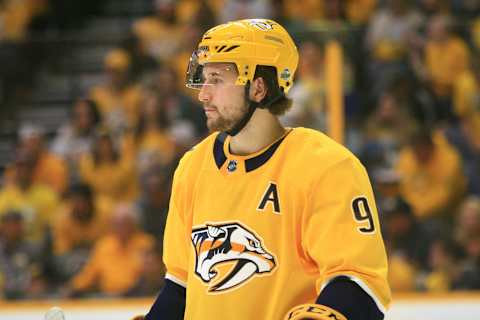
. Forward. Nashville Predators. Filip Forsberg. 10. player. 151
Filip Forsberg has emerged as one of the NHL’s most dynamic and productive wings. He’s asked to carry a heavy load on offense as the Nashville Predators’ top point scorer in three of the past four seasons. Forsberg has at least 60 points in three of those seasons, and in the other, he put up 58.
He’s set the bar pretty high for himself entering the 2018-19 season, but don’t be surprised if he becomes a point per game player.
Last season, he finished 14th among forwards in five-on-five points per hour and first in primary assists per hour. Forsberg provides countless highlight-reel plays and his ability to shoot and pass makes him very hard to account for. Had he not missed 15 games, he might have had his third consecutive season with at least 30 goals.
To top it all off, Forsberg has been impressive in each of the past two postseasons. In 35 games, he has posted 16 goals and 32 points. Forsberg and Viktor Arvidsson (who barely missed eligibility with an April birthday) are among the most lethal wing duos in the NHL.
His possession numbers are not as outstanding as others, but he’s consistently a net gain as far as shot attempts and scoring chances. A two-way wing who can produce like Forsberg is an incredibly valuable thing. He’s set the bar pretty high for himself entering the 2018-19 season, but don’t be surprised if he becomes a point per game player.
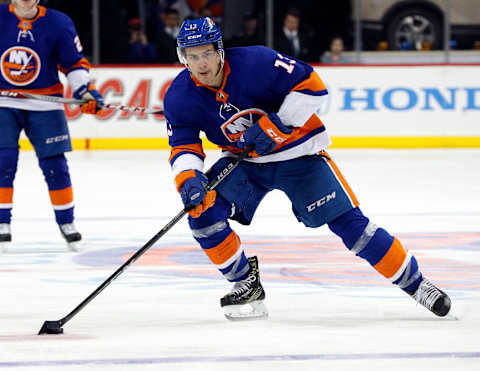
Mathew Barzal. 9. player. 106. . Forward. New York Islanders
Mathew Barzal had one of the best rookie seasons in recent memory last season. He dazzled fans on a nightly basis, posting multiple five-point games. At just 21 years old, “the kid who won the Calder” is now the man for the Islanders after John Tavares signed with the Toronto Maple Leafs.
If Barzal can replicate (or dare I say improve?) on his breakout season from out of nowhere, he could be in the top five next year.
Can Barzal be a true number one center like Tavares? That remains to be seen. Yes, Barzal outproduced Tavares, but teams will be able to hone in on stopping him now. The Islanders will be asking him to carry the load on offense, which will be a tall order given their roster.
Barzal’s possession numbers last season were nearly as impressive as his point totals, which is an encouraging sign. Because, boy, was Barzal a force on offense. Only four forwards had a higher five-on-five points per hour rate – Kucherov, Matthews, MacKinnon, and McDavid. Barzal is terrific at creating space for his teammates and setting them up for excellent scoring chances.
He could have been even higher on this list, but I was reluctant to say he’s a number one center when he hasn’t truly proven it yet. If Barzal can replicate (or dare I say improve?) on his breakout season from out of nowhere, he could be in the top five next year.
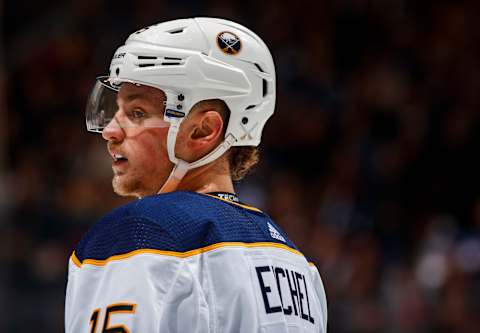
Jack Eichel. 8. player. 12. . Forward. Buffalo Sabres
Jack Eichel is one of the best young centers in the NHL. Despite playing on a horrible Sabres team that finished last in the league in scoring, he still finished just outside the top 40 forwards in points per hour during all situations. With better linemates this season, there’s no reason to believe Eichel’s numbers won’t go up.
Only 16 forwards generated more shots on goal per hour than Eichel last year. That’s a minor miracle considering the team around him.
He’s missed time due to injuries, but has still seen his point total grow each season. Eichel has yet to hit the point per game milestone over a full season, but he’s come darn close in each of the past two seasons. He’s still just 21 years old, so fans haven’t seen the best from him yet.
Eichel has yet to score less than 20 goals in a season. And even though his shots per game rate fell from over four in 2016-17 to 3.67 in 2017-18, that’s likely more due to injuries than anything else. Only 16 forwards generated more shots on goal per hour than Eichel last year. That’s a minor miracle considering the team around him.
Islanders fans are probably mad Eichel’s above Barzal. I think they’re both amazing players. But Eichel has a larger track record and has had to be the guy from the moment he signed his entry-level contract. This will be the first year that’s the case with Barzal.

Forward. Edmonton Oilers. Leon Draisaitl. 7. player. 148.
Last summer, the Edmonton Oilers signed Leon Draisaitl to a long-term extension. At the time, I didn’t like the deal because it paid him like he was someone who can drive his own line. And at that point in his career, Draisaitl had yet to show he could be one of those guys.
Draisaitl has become more than just McDavid’s sidekick and should see better numbers this season.
Allow me to eat crow because last season, he proved he can drive his own line. Though Draisaitl still spent about 60 percent of his five-on-five minutes with Connor McDavid, he showed he can drive his own line even though the Oilers didn’t give him ideal linemates. For his second straight season, he hit the 20 goal plateau.
On paper, his point total went from 77 to 70, but there’s some necessary context. First of all, Draisaitl missed four games in 2017-18. Secondly, he saw an increase in his five-on-five points from 40 to 43 and even strength points from 50 to 55 despite playing fewer minutes.
Draisaitl was a force as far as possession too, finishing with an even strength relative CorsiFor percentage of 3.98 percent. He drove the Oilers second line and made it a lot better than it was without him. Draisaitl has become more than just McDavid’s sidekick and should see better numbers this season.
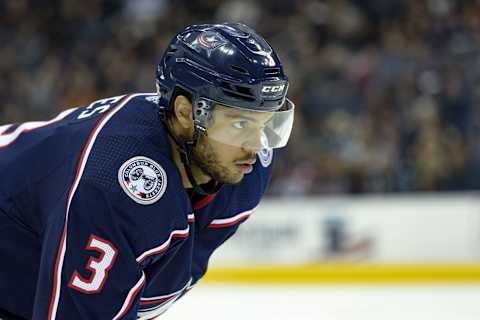
Columbus Blue Jackets defenseman Seth Jones is the highest ranked defenseman on this list. It’s easy to see why. Jones finished fourth place in the Norris Trophy voting last season as a 23-year-old. He’ll enter the 2018-19 season not just as a 24-year-old, but also as a Norris Trophy candidate.
With Werenski and Jones leading their top pairing, Columbus is a threat to win the Stanley Cup.
Last season, Jones finished tied for 13th among all defensemen with 27 five-on-five points. Additionally, his 13 primary assists at five-on-five ranked ninth. Jones was among the top 30 defensemen (minimum 500 minutes played) in five-on-five points per hour, goals per hour, and primary assists per hour. Only Brent Burns and Dougie Hamilton generated more shots on goal per hour than him.
Jones is easily one of the best defensemen in the NHL. Few blueliners make a bigger impact on their team than him. Among defensemen, Jones ranked 17th in relative CorsiFor percentage and 12th in relative FenwickFor percentage. He also scored 16 goals and picked up 41 assists for a career-high 57 points last season.
The Blue Jackets might be on the verge of losing Artemi Panarin and/or Sergei Bobrovsky, but at least they have Jones to look forward to. With Werenski and Jones leading their top pairing, Columbus is a threat to win the Stanley Cup.
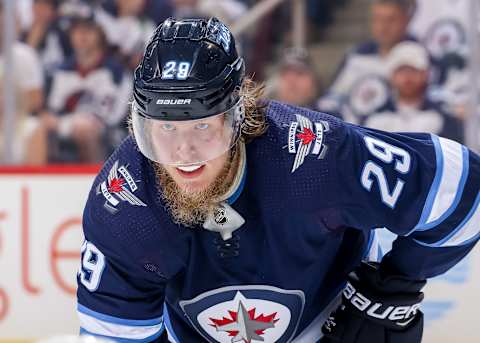
player. 30. . Forward. Winnipeg Jets. Patrik Laine. 5
Patrik Laine came into the league with a lot of hype as the second overall pick of the 2016 NHL Draft. The Winnipeg Jets sniper has done more than merely live up to it. He has exceeded it and is doing laps around it.
Laine’s goal scoring is his calling card. Through his first two seasons, he has 80 goals. Only two players (Jimmy Carson and Dale Hawerchuk) scored more goals before their 20th birthday than him. His passing doesn’t get much love, but he does have 54 assists in his first two seasons, which isn’t bad at all.
Hot. Greatest Player To Wear Each Jersey Number. light
A lot of people compare Laine to Alex Ovechkin, but that’s a lazy comparison. He’s much closer to Steven Stamkos. Ovechkin is a heavy volume shooter, meaning he scores goals because of the sheer volume of shots he puts on goal each game.
Stamkos, however, is more selective and relies on his outstanding shooting percentage. Through two seasons, Laine has an 18 percent shooting percentage. His lightning quick release is extremely powerful, making him a nightmare for opposing goaltenders.
Going into his third season, I’d love to see Laine shoot the puck more. It’s really hard to argue with his selectivity given his success, but his shot is so darn lethal, I think there’s a whole new level of greatness for him that we haven’t seen yet as fans.
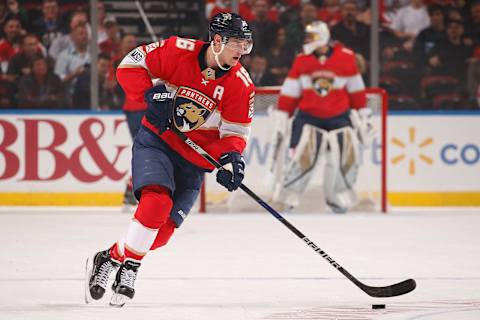
Forward. Florida Panthers. Aleksander Barkov. 4. player. 87.
Aleksander Barkov is outrageously good. The Florida Panthers center isn’t that well known yet, but that should change very quickly. Barkov is building off a breakout season and has emerged as one of the NHL’s most unique and dynamic talents.
He’s a very good scorer, as his 27 goals and 78 points from 2017-18 show. But what’s really impressive about Barkov is his 200 foot game. Other than Patrice Bergeron and Sean Couturier, there might not be a better center in all three zones than him.
Trending. Which Number Should Each Team Retire Next?. light
Barkov was especially outstanding while killing penalties last year. When he was on the ice, opposing power plays scored just seven goals in a shade over 138 minutes. Barkov scored five shorthanded goals. So he nearly outscored the opposing power plays by himself.
Entering the 2018-19 season, he should be on everyone’s Hart Trophy watch list. Especially if voters stick to last season’s strategy of “vote for the best guy on a fringe playoff team”. After last season, there’s no reason why the Panthers shouldn’t make the playoffs. Barkov plays during all situations and will most likely have a very gaudy point total. Could that add up to a Hart Trophy?
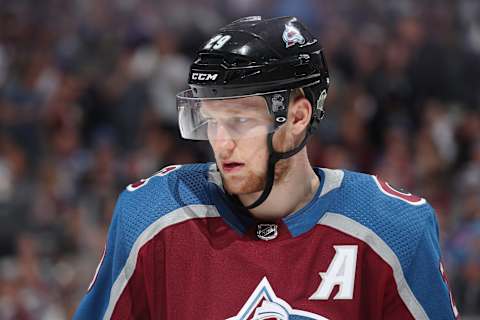
103. . Forward. Colorado Avalanche. Nathan MacKinnon. 3. player
The Colorado Avalanche got a huge breakout season from star center Nathan MacKinnon in 2017-18. Before the season, he was a very good player who showed glimpses of greatness but didn’t let it show enough. It’s safe to say MacKinnon let it show, as he finished as a Hart Trophy finalist and arguably should have won the award.
He set career highs with 39 goals, 58 assists, and 97 points. Had it not been for an injury that cost him eight games, he would likely have joined Connor McDavid, Nikita Kucherov, and Claude Giroux in the 100 point club.
Must Read. Avalanche Season Preview. light
MacKinnon finished ninth among all forwards in five-on-five primary assists per hour (minimum 500 minutes). Additionally, he finished seventh in goals per hour, second in points per hour, and 12th in total assists per hour. MacKinnon also had the 20th highest average ice time per game at five-on-five. He helped the Avalanche nearly double their point total from 2016-17 to 2017-18.
Going into the 2018-19 season, the Avalanche will need him to be on top of his game again. MacKinnon will be asked to lead their top line, which will be counted on to score a lot of goals. He’ll likely have to take on some more defensive responsibilities as well.

Auston Matthews was drafted by the Toronto Maple Leafs with the first overall pick of the 2016 NHL Draft. Thanks to an outstanding career, he was thought of as arguably the best American forward to come along since Patrick Kane. Thus far, Matthews has lived up to those great expectations.
Since joining the league, no one has scored more five-on-five goals than his 55 points. Matthews’ 1.58 five-on-five goals per hour rate is the highest during that span as well. His 86 five-on-five points sounds a bit low, but it’s worth noting 77 of those 86 points are primary points and he ranks third in primary points. Only Kane and Connor McDavid have more.
light. Related Story. Maple Leafs All-Time Dream Team
Of Matthews’ 132 points, only 34 have come on the power-play. While he doesn’t put up as many points on the man advantage as others, five-on-five play is the most important part of every game. Matthews is outstanding at five-on-five, which more than makes up for his unimpressive power play numbers.
Even though he missed 20 games last season, he still manage to score 34 goals and pick up 63 points. Matthews was on pace to shatter his rookie season marks of 40 goals and 69 points.
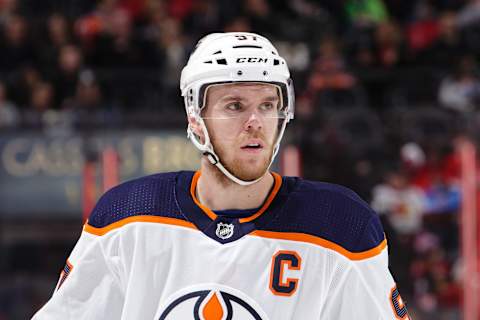
Connor McDavid. 1. player. 148. . Forward. Edmonton Oilers
Not only is Connor McDavid the best player who’s under 25 years old, he’s the best darn player in the league. He’s won the past two Ted Lindsay Awards, which is given to the player’s choice of the “most outstanding player”. It isn’t seen as prestigious as the Hart Trophy, but it really should be. Especially once you consider McDavid improved from his 2016-17 Hart winning campaign and didn’t repeat because the Oilers were that awful.
His 3.04 five-on-five points per hour since the start of the 2016-17 leads the NHL (minimum 1500 minutes). McDavid also has 2.3 primary points per hour, which trails only Evgeni Malkin’s 2.31. Despite the unbelievable amount of minutes he plays (2,640 at five-on-five to be exact), he’s still among the league leaders in relative CorsiFor percentage during that span as well.
McDavid narrowly missed becoming having three straight seasons with at least 100 era-adjusted points to open his career. He was on pace to push that total in his rookie season before a broken collarbone sidelined him.
Next. One Reason Each Team Should Be Excited For Next Season. dark
There’s not much more to say about McDavid other than he’s taken the throne of “best player” away from Sidney Crosby much earlier than anyone could have anticipated. He’ll hold down the throne of “best player under 25” until he turns 25.